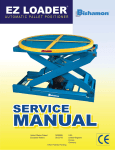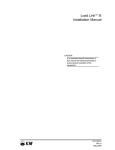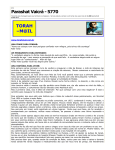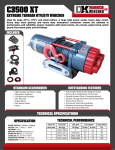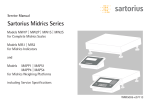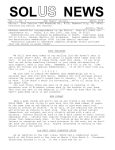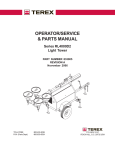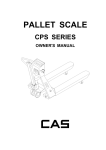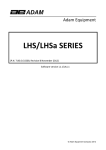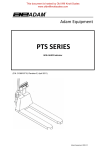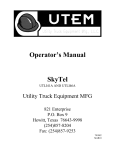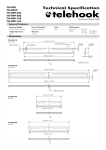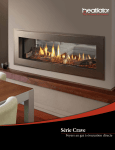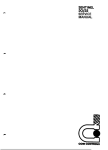Download Bishamon Vision Owner`s Manual - Lift
Transcript
™ Service Bishamon Industries Corporation 5651 E. Francis St. Ontario, CA. 91761 (909) 390-0055 (800) 231-3187 PATENT PENDING Vision Series Service Manual Copyright © 2000, Bishamon Industries Corporation All Rights Reserved Table of Contents Contents Page Getting Started . . . . . . . . . . . . . . . . . . . . . . . . . . . . . . . . . . . . . . . . . . . . . . . . . . . . . . . . . . . . . . . . . . . . .1 Inspection . . . . . . . . . . . . . . . . . . . . . . . . . . . . . . . . . . . . . . . . . . . . . . . . . . . . . . . . . . . . . . . . . . . . . . . . .1 Safety Definitions. . . . . . . . . . . . . . . . . . . . . . . . . . . . . . . . . . . . . . . . . . . . . . . . . . . . . . . . . . . . . . . . . . .1 General Dangers, Warnings, and Cautions. . . . . . . . . . . . . . . . . . . . . . . . . . . . . . . . . . . . . . . . . . . . . .1 Responsibilities of Owners/Users . . . . . . . . . . . . . . . . . . . . . . . . . . . . . . . . . . . . . . . . . . . . . . . . . . . . .4 Specifications. . . . . . . . . . . . . . . . . . . . . . . . . . . . . . . . . . . . . . . . . . . . . . . . . . . . . . . . . . . . . . . . . . . . . .4 Specification Drawing . . . . . . . . . . . . . . . . . . . . . . . . . . . . . . . . . . . . . . . . . . . . . . . . . . . . . . . . . . . . . . .5 Recommended Floor Area . . . . . . . . . . . . . . . . . . . . . . . . . . . . . . . . . . . . . . . . . . . . . . . . . . . . . . . . . . .6 Functional Description . . . . . . . . . . . . . . . . . . . . . . . . . . . . . . . . . . . . . . . . . . . . . . . . . . . . . . . . . . . . . .7 Maintenance Catch Operating Instructions . . . . . . . . . . . . . . . . . . . . . . . . . . . . . . . . . . . . . . . . . . . . .7 Installation . . . . . . . . . . . . . . . . . . . . . . . . . . . . . . . . . . . . . . . . . . . . . . . . . . . . . . . . . . . . . . . . . . . . . . . .8 Lift Operating Instructions . . . . . . . . . . . . . . . . . . . . . . . . . . . . . . . . . . . . . . . . . . . . . . . . . . . . . . . . . .10 Raising the Lift Platform . . . . . . . . . . . . . . . . . . . . . . . . . . . . . . . . . . . . . . . . . . . . . . . . . . . . . . .10 Loading / Unloading the Lift Platform . . . . . . . . . . . . . . . . . . . . . . . . . . . . . . . . . . . . . . . . . . . .10 Lowering the Lift Platform . . . . . . . . . . . . . . . . . . . . . . . . . . . . . . . . . . . . . . . . . . . . . . . . . . . . .11 Routine Maintenance. . . . . . . . . . . . . . . . . . . . . . . . . . . . . . . . . . . . . . . . . . . . . . . . . . . . . . . . . . . . . . .11 Daily Inspection . . . . . . . . . . . . . . . . . . . . . . . . . . . . . . . . . . . . . . . . . . . . . . . . . . . . . . . . . . . . . .11 Monthly Inspection and Maintenance . . . . . . . . . . . . . . . . . . . . . . . . . . . . . . . . . . . . . . . . . . . .12 Changing the Hydraulic Fluid . . . . . . . . . . . . . . . . . . . . . . . . . . . . . . . . . . . . . . . . . . . . . . . . . . .13 Cylinder Seal Replacement. . . . . . . . . . . . . . . . . . . . . . . . . . . . . . . . . . . . . . . . . . . . . . . . . . . . .15 Trouble Shooting . . . . . . . . . . . . . . . . . . . . . . . . . . . . . . . . . . . . . . . . . . . . . . . . . . . . . . . . . . . . . . . . . .15 Electrical Schematics . . . . . . . . . . . . . . . . . . . . . . . . . . . . . . . . . . . . . . . . . . . . . . . . . . . . . . . . . . . . . .16 Hydraulic Schematic . . . . . . . . . . . . . . . . . . . . . . . . . . . . . . . . . . . . . . . . . . . . . . . . . . . . . . . . . . . . . . .18 Replacement Parts . . . . . . . . . . . . . . . . . . . . . . . . . . . . . . . . . . . . . . . . . . . . . . . . . . . . . . . . . . . . . . . .18 Exploded Parts Drawing and Parts List Vision Single Cylinder Lift Exploded View . . . . . . . . . . . . . . . . . . . . . . . . . . . . . . . . . . . . . . . . . . . . .19 Vision Single Cylinder Lift Parts List. . . . . . . . . . . . . . . . . . . . . . . . . . . . . . . . . . . . . . . . . . . . . . . . . .21 Vision Dual Cylinder Lift Exploded View. . . . . . . . . . . . . . . . . . . . . . . . . . . . . . . . . . . . . . . . . . . . . . .24 Vision Dual Cylinder Lift Parts List . . . . . . . . . . . . . . . . . . . . . . . . . . . . . . . . . . . . . . . . . . . . . . . . . . .26 Vision Single Cylinder Hydraulic Exploded View. . . . . . . . . . . . . . . . . . . . . . . . . . . . . . . . . . . . . . . .29 Vision Single Cylinder Hydraulic Parts List . . . . . . . . . . . . . . . . . . . . . . . . . . . . . . . . . . . . . . . . . . . .30 Vision Dual Cylinder Hydraulic Exploded View . . . . . . . . . . . . . . . . . . . . . . . . . . . . . . . . . . . . . . . . .31 Vision Dual Cylinder Hydraulic Parts List. . . . . . . . . . . . . . . . . . . . . . . . . . . . . . . . . . . . . . . . . . . . . .32 Vision Electrical Exploded View . . . . . . . . . . . . . . . . . . . . . . . . . . . . . . . . . . . . . . . . . . . . . . . . . . . . .33 Vision Electrical Parts List . . . . . . . . . . . . . . . . . . . . . . . . . . . . . . . . . . . . . . . . . . . . . . . . . . . . . . . . . .34 List of Figures Fig. 1 - Safety Warning Label Locations . . . . . . . . . . . . . . . . . . . . . . . . . . . . . . . . . . . . . . . . . . . . . . .3 Fig. 2 - Lift Specification Drawing . . . . . . . . . . . . . . . . . . . . . . . . . . . . . . . . . . . . . . . . . . . . . . . . . . . .5 Fig. 3 - Recommended Floor Area . . . . . . . . . . . . . . . . . . . . . . . . . . . . . . . . . . . . . . . . . . . . . . . . . . . .6 Fig. 4 - Maintenance Catch Details . . . . . . . . . . . . . . . . . . . . . . . . . . . . . . . . . . . . . . . . . . . . . . . . . .7 Fig. 5 - Installation Components. . . . . . . . . . . . . . . . . . . . . . . . . . . . . . . . . . . . . . . . . . . . . . . . . . . .8 Fig. 6 - Handling the Vision Lift. . . . . . . . . . . . . . . . . . . . . . . . . . . . . . . . . . . . . . . . . . . . . . . . . . . . .9 Fig. 7 - Anchor Bolt Detail . . . . . . . . . . . . . . . . . . . . . . . . . . . . . . . . . . . . . . . . . . . . . . . . . . . . . . . .10 Fig. 8 - Hand Control Operation . . . . . . . . . . . . . . . . . . . . . . . . . . . . . . . . . . . . . . . . . . . . . . . . . . .10 Fig. 9 - Foot Control Operation . . . . . . . . . . . . . . . . . . . . . . . . . . . . . . . . . . . . . . . . . . . . . . . . . . . .10 Fig. 10 - Hydraulic Fluid Drain Detail . . . . . . . . . . . . . . . . . . . . . . . . . . . . . . . . . . . . . . . . . . . . . . . .13 Fig. 11 - Cylinder Hydraulic Fluid Removal Detail. . . . . . . . . . . . . . . . . . . . . . . . . . . . . . . . . . . . . .14 Fig. 12 - 115 Volt, Single Phase Electrical Schematic . . . . . . . . . . . . . . . . . . . . . . . . . . . . . . . . . . 16 Fig. 13 - 230 Volt, Single Phase Electrical Schematic . . . . . . . . . . . . . . . . . . . . . . . . . . . . . . . . . . 16 Fig. 14 - 230 Volt, Three Phase Electrical Schematic . . . . . . . . . . . . . . . . . . . . . . . . . . . . . . . . . . .17 Fig. 15 - 460 Volt, Three Phase Electrical Schematic . . . . . . . . . . . . . . . . . . . . . . . . . . . . . . . . . . .17 Fig. 16 - Hydraulic Schematic . . . . . . . . . . . . . . . . . . . . . . . . . . . . . . . . . . . . . . . . . . . . . . . . . . . . . .18 List of Tables Table 1 - Operating Temperature / Recommended Hydraulic Fluid . . . . . . . . . . . . . . . . . . . . . . . 14 Date Placed in Service ______________________________________________ Serial Number______________________________________________________ Dealer ____________________________________________________________ GETTING STARTED PLEASE READ THIS MANUAL CAREFULLY BEFORE USING THE Vision ™ Scissor Lift Table. The safety of all persons installing, using or servicing the Vision™ lift table is of utmost importance to Bishamon. The Vision™ lift is capable of supporting heavy loads and is capable of causing SEVERE PERSONAL INJURY if used improperly or if certain safety precautions are not taken. When properly used and maintained, the Vision™ lift will provide many years of safe, trouble free service. If you have any questions about any of the instructions in this manual or about the use of this product, PLEASE contact your DEALER or Bishamon Industries Corporation. Vision™ is a trademark of Bishamon Industries Corporation. Throughout this service manual the Vision™ scissor lift table may be referred to as the “lift table” or the “lift”. INSPECTION IMMEDIATELY upon receipt of the lift table remove all the packing and strapping material and visually inspect the unit for damage. Any damage to the unit MUST BE NOTED on the delivery receipt. After the preliminary inspection is conducted, the unit should be thoroughly inspected for any concealed damage that was not readily apparent during the preliminary inspection. Any concealed damage found that was not noted on the delivery receipt should be IMMEDIATELY reported in writing TO THE DELIVERING CARRIER. SAFETY DEFINITIONS Bishamon uses the following system to identify the degree of risk associated with hazards and unsafe practices: DANGER - Immediate hazard which will result in SEVERE PERSONAL INJURY or DEATH. WARNING - Hazard or unsafe practice which could result in SEVERE PERSONAL INJURY or DEATH and PROPERTY DAMAGE. CAUTION - Hazard or unsafe practice which could result in MINOR PERSONAL INJURY and PROPERTY DAMAGE. GENERAL DANGERS, WARNINGS, AND CAUTIONS DANGER READ THIS MANUAL COMPLETELY BEFORE USING. THOROUGHLY UNDERSTAND AND FOLLOW ALL SAFETY INSTRUCTIONS. A falling lift table can cause SEVERE PERSONAL INJURY or DEATH. NEVER go under the platform until the load is removed and the scissor mechanism is secured in the raised position with the maintenance catches. The maintenance catches have been designed for use only when the lift is UNLOADED. NEVER place any load on the platform with the maintenance catches engaged. SEVERE PERSONAL INJURY or DEATH and PROPERTY DAMAGE could result. NEVER sit, stand, or ride on the platform. Moving components could cause loss of balance. SEVERE PERSONAL INJURY or DEATH could result. The lift’s electrical circuits use voltages which can cause SEVERE PERSONAL INJURY or DEATH. DO NOT work with the electrical components unless you are a QUALIFIED ELECTRICIAN. The lift’s electrical components can create sparks. DO NOT install the lift in an area where potentially explosive dusts, gases, or vapors may be present. Failure to comply may result in an explosion and cause SEVERE PERSONAL INJURY or DEATH. 1 Vision WARNING The Vision™ lift table is designed for use with stable uniformly distributed loads on a solid level floor. DO NOT concentrate the load at one point on the platform or pallet. ALWAYS uniformly distribute each layer of load over the supporting surface. DO NOT use the lift for any purpose other than its intended use. DO NOT install the Vision™ lift table on an unlevel or soft surface. The lift base frame must be supported along its entire length and width. Failure to completely support the base frame could result in damage to the lift. DO NOT use the lift table with an unstable, unbalanced, or loosely stacked load. Unbalanced loads may become unstable and fall. SEVERE PERSONAL INJURY and PROPERTY DAMAGE could result. DO NOT overload the lift table. ALWAYS stay within the designated capacity ratings. SEVERE PERSONAL INJURY and PROPERTY DAMAGE could result. SHEARING HAZARD. ALWAYS keep hands and feet clear of the scissor mechanism and all moving components. DO NOT put hands or fingers under the platform when in use. SEVERE PERSONAL INJURY could result. CRUSHING HAZARD. ALWAYS keep hands and feet clear of all moving components. DO NOT put feet on the base frame when in use. SEVERE PERSONAL INJURY could result. PINCH POINT HAZARD. ALWAYS keep feet, hands, and fingers away from the underside of the platform and all moving components. SEVERE PERSONAL INJURY could result. DO NOT change the relief valve setting. The relief valve is installed to protect the operator and the lift table. Changing the relief valve setting may cause the lift to suddenly fall. SEVERE PERSONAL INJURY and PROPERTY DAMAGE could result. NEVER leave the loaded lift table unattended unless the platform is in the fully lowered position. ALL lift servicing must be performed by qualified personnel only. Unauthorized modifications to the lift table, its hydraulic power unit, or its control system may compromise the performance and safety of the system. UNDER NO CIRCUMSTANCES should you attempt any repair or service that is not covered in this manual. The release of fluids under high pressure can cause SEVERE PERSONAL INJURY. Before servicing the lift, ALWAYS remove the entire load, engage the maintenance catches, and RELEASE THE HYDRAULIC PRESSURE. ALWAYS ensure all safety warning labels are in place and legible. If not, remove the lift table from service and replace the required labels. Refer to Figure 1 for label descriptions and locations. ALWAYS securely anchor the base frame to the floor to ensure maximum stability. CAUTION DO NOT continue to operate the pump if a squealing noise is heard coming from the pump. The pressure relief valve is operating. Continued use of the pump with the relief valve operating will cause permanent damage to the pump. REDUCE the load to prevent the relief valve from operating. Vision 2 DANGER READ MANUAL SHEAR HAZARD NO RIDING 1. READ THE MANUAL COMPLETELY BEFORE USING AND THOROUGHLY UNDERSTAND AND FOLLOW ALL SAFETY INSTRUCTIONS. 2. A falling lift table can cause SEVERE PERSONAL INJURY or DEATH. NEVER go under the platform until the load is removed and the scissor mechanism is secured in the raised position with the maintenance devices. 3. The maintenance devices have been designed for use only when the lift is UNLOADED. NEVER place any load on the platform with the maintenance devices engaged. SEVERE PERSONAL INJURY or DEATH and PROPERTY DAMAGE could result. 4. NEVER sit, stand or ride on the platform. Moving components could cause loss of balance. SEVERE PERSONAL INJURY or DEATH could result. CRUSH HAZARD KEEP CLEAR MEC\B2000447 USE MAINTENANCE DEVICES MAXIMUM LIFTING CAPACITY 2500 lbs 1,130 kgs UNIFORMLY DISTRIBUTED LOADS ALL LOADS MUST BE CENTERED FOR PROPER OPERATION NEVER EXCEED CAPACITY RATINGS MEC-B2001340 CAUTION The electric motor for this unit has an Intermittent Duty Rating. Make sure the frequency of operation does not exceed on full lift every two minutes. WARNING NEVER GO UNDER THE PLATFORM UNTIL THE LOAD IS REMOVED AND THE SCISSOR MECHANISM IS LATCHED. MEC-B2000528 OIL VISCOSITY RECOMMENDATIONS MEC\B2001338 POWER SUPPLY 230V / 3PH / 60HZ MEC-B2000630 Best performance of the pump can be obtained by utilizing proper oil with a viscosity range between 150-250 SUS @ 100º F (32-54 cSt @ 40ºC). Minimum viscosity at operating temperature should be at least 60 S US (10 cSt). Maximum start-up viscosity at minimum ambient temperature should not exceed 4000 S US (880 cSt). Maximum recommended operating temperature of hydraulic oil is 150ºF (65º C). Oil S hould be non-corrosive, have maximum anti-wear properties, rust and oxidation treatment, and be non-foaming. Recommended list of oils for ambient temperature range of -10º F to +100º F (-23º C to + 38º C) are as follows: 1. Amoco Oil Co.-Rycon Oil -32, 46; Amoco AW 32, 46 2. Cities Service Oil Co.-Citgo A /W Hyd. Oil 32, 46; Citgo All Temp. Hyd. Oil 3. Chevron US A-C hevron EP Hyd. Oil 32, 46. 4. Fina Oil Co.-Fina A/W 32, 46; Fina Automatic Transmission Fluid Dexron II 5. Gulf Oil Corporation-Gulf Harmony 32 A/W, 46 A/W. 6. Mobil Oil Corporation-DTE 15, 24, 25, Mobile Fluid -300 Transmission Fluid. 7. Sentinel Lubricants Corp.-S entinel SH-10 Hydraulic Oil. 8. Shell Oil Co.-Tellus Hyd. Oil 32, 46; Tellus “T” Hyd. Oil 32, 46. 9. Texaco Inc.-Rando Oil Hyd. 32,46. 10. Union 76-X’Cel A/W 46 (200) NOTE: DO NOT USE BRA KE FLUID MEC-B2001337 WARNING NO FOOT Note: VIS-25-36 decals shown for reference only Figure 1 - Safety Warning Label Locations 3 Vision RESPONSIBILITIES OF OWNERS/USERS It is the responsibility of the Owners/Users to: 1. Advise the DEALER or Bishamon Industries Corporation when deflection or creep is critical to the application. 2. Ensure the lift is inspected and maintained in proper working order in accordance with the operation/maintenance instructions provided in this manual. 3. Ensure any lift not in safe operating condition such as, but not limited to, excessive leakage, missing rollers, pins or fasteners, bent or cracked structural members, cut or frayed hydraulic lines, damaged or malfunctioning controls or safety devices, etc. shall be removed from service until it is repaired to Bishamon’s standards. 4. Ensure all repairs are made by qualified personnel in conformance with the instructions provided by Bishamon Industries Corporation. 5. Ensure only trained and authorized personnel are permitted to operate the lift and that all operators understand the operating instructions, safety rules, and hazards associated with this lift. 6. Ensure the lift is used in accordance with the guidelines provided in this manual. 7. Ensure modifications or alterations of any lift are made only with the written permission of Bishamon Industries Corporation. VISION SPECIFICATIONS Lift Capacity Lowered Raised Platform Plaform Travel Weight Height Height Width Length 24 in. to 48 in. 48 in. to 72 in. 2500-36 2500LB 1134Kg 7 in. 178 mm 43 in. 1092 mm 36 in. 914 mm 610 mm to 1219 mm 1219mm to 1829mm 3500-36 3500LB 1588Kg 7 7/16 in. 189 mm 43 7/16 in. 1103 mm 36 in. 914 mm 24 in. to 48 in. 48 in. to 72 in. 610 mm to 1219 mm 1219mm to 1829mm 5000-36 5000LB 2268Kg 7 1/2 in. 191 mm 43 1/2 in. 1105 mm 36 in. 914 mm 24 in. to 48 in. 48 in. to 72 in. 24 mm to 1219 mm 1219mm to 1829mm 6500-36 6500LB 2948Kg 7 1/2 in. 191 mm 43 1/2 in. 1105 mm 36 in. 914 mm 24 in. to 48 in. 48 in. to 72 in. 610 mm to 1219 mm 1219mm to 1829mm 1500-48 1500LB 680Kg 7 3/8 in. 187 mm 55 3/8 in. 1407 mm 48 in. 1219 mm 30 in. to 48 in. 62 1/2 in. to 96 in. 762 mm to 1219 mm 1588mm to 2438mm 2500-48 2500LB 1134Kg 7 3/8 in. 187 mm 55 3/8 in. 1407 mm 48 in. 1219 mm 30 in. to 48 in. 62 1/2 in. to 96 in. 762 mm to 1219 mm 1588mm to 2438mm 3500-48 3500LB 1588Kg 7 1/2 in. 191 mm 55 1/2 in. 1410 mm 48 in. 1219 mm 30 in. to 48 in. 62 1/2 in. to 96 in. 762 mm to 1219 mm 1588 to 2438mm 5000-48 5000LB 2268Kg 7 1/2 in. 191mm 55 1/2 in. 1410 mm 48 in. 1219 mm 30 in. to 48 in. 62 1/2 in. to 96 in. 762 mm to 1219 mm 1588mm to 2438mm 6500-48 6500LB 2948Kg 7 3/4 in. 197 mm 55 3/4 in. 1416 mm 48 in. 1219 mm 30 in. to 48 in. 62 1/2 in. to 96 in. 762 mm to 1219 mm 1588mm to 2438mm 2500-24 2500LB 1134Kg 7 in. 178 mm 31 in. 787 mm 24 in. 610 mm 24 in. to 48 in. 41 in. to 60 in. 610 mm to 1219 mm 1041mm to 1524mm 3500-24 3500LB 1588Kg 7 1/8 in. 181 mm 31 1/8 in. 791 mm 24 in. 610 mm 24 in. to 48 in. 41 in. to 60 in. 610 mm to 1219 mm 1041mm to 1524mm 5000-24 5000LB 2268Kg 7 1/8 in. 181 mm 31 1/8 in. 791 mm 24 in. 610 mm 24 in. to 48 in. 41 in. to 60 in. 610 mm to 1219 mm 1041mm to 1524mm 6500-24 6500LB 2948Kg 7 1/8 in. 181 mm 31 1/8 in. 791 mm 24 in. 610 mm 24 in. to 48 in. 41 in. to 60 in. 610 mm to 1219 mm 1041mm to 1524mm Vision 4 590LB 625LB 735LB 750LB 885 LB 895 LB 1030 LB 1050 LB 1060 LB 445 LB 455 LB 640 LB 655 LB ADDITIONAL SPECIFICATIONS AND SPECIFICATION DRAWING SPECIFICATIONS: 1. Sound Pressure Level <70dB(a) 2. Operating Environment Indoors 3. Lighting Requirement Good General Lighting (See Table 1) PLATFORM LENGTH BASE LENGTH LOWERED HEIGHT PLATFORM WIDTH TRAVEL RAISED HEIGHT 4. Operating Temperature BASE WIDTH Vision Series Figure 2 - Lift Specification Drawing 5 Vision RECOMMENDED FLOOR AREA Operating Zone 39 inches 1 meter 39 inches 1 meter Lift Table Danger Zone 39 inches 1 meter 39 inches 1 meter Figure 3 - Recommended Floor Area The lift table’s recommended floor area, shown in Figure 3, identifies the “Danger Zone” and the “Operating Zone”. The Danger Zone is the area inside the base frame and under the platform structure. The recommended Operating Zone is a distance of 39 inches (1 meter) extending beyond the danger zone on all sides. DANGER A falling lift table can cause SEVERE PERSONAL INJURY or DEATH. NEVER go under the platform until the load is removed and the scissor mechanism is latched with the maintenance catches. The maintenance catches have been designed for use only when the lift is UNLOADED. NEVER place any load on the platform with the maintenance catches engaged. SEVERE PERSONAL INJURY or DEATH and PROPERTY DAMAGE could result. Vision 6 FUNCTIONAL DESCRIPTION Vision Series lift tables are versatile and heavy-duty. These electro-hydraulic scissor lift tables are designed and manufactured to increase productivity and reduce worker strain. By lifting and accurately positioning the load, Vision lifts eliminate unproductive lifting and stretching that ultimately leads to worker fatigue, injuries, and product damage. They are well suited for handling a wide variety of products including work in progress, palletized loads, containers, bins, tools, and dies. Vision Lifts are available in 1500 lb, 2500 lb, 3500 lb, 5000 lb and 6500 lb capacities (1500 lb is only available in the 48 inch vertical travel model) and 24 inch, 36 inch and 48 inch vertical travels. The platform position is completely variable in height between the upper and lower travel limits. Lowered height is 7 inches to 7 ¾ inches depending on the model (see Vision Specifications). Depressing the “RAISE” control actuates the hydraulic power unit and directs hydraulic fluid to the piston side of a single, single-acting cylinder. The cylinder rod extends and opens the scissor assembly, which in turn raises the platform. Lowering is achieved by depressing the “LOWER” control actuating a solenoid valve at the hydraulic power unit. Opening the valve allows hydraulic fluid to flow out of the cylinder and return to the reservoir. A pressure compensated flow control valve within the power unit controls the lowering speed. MAINTENANCE CATCH OPERATING INSTRUCTIONS To Engage The Maintenance Catches: 1. Remove the entire load from the platform and raise the lift table to its fully raised position. 2. Move to the side of the lift. As detailed in Figure 4, rotate the maintenance catch until the catch arm engages the outer scissor leg axle. 3. Move to the opposite side of the lift and repeat step 2 for the other catch arm. ALWAYS ensure BOTH catch arms are engaged. 4. Slowly lower the lift by depressing the lowering control button or pedal. The lift will lower slightly until the maintenance catches completely engage the axle. ALWAYS check the position of both maintenance catches before going under the platform. ENGAGED DISENGAGED Figure 4 - Maintenance Catch Details To Disengage The Maintenance Catches: 1. Raise the platform to its fully raised position. 2. Move to the side of the lift and rotate the maintenance catch to its disengaged position (See Figure 4). 3. Repeat step two (2) for opposite side of the lift. 7 Vision INSTALLATION The Vision™ lift table is shipped on a pallet and only requires minor assembly before it is ready for use. Before you begin, locate and identify the components detailed in Figure 5. These components will be referred to in the installation procedures. Make sure you understand the function of each component before proceeding. TOOLS REQUIRED 1. Banding or Strap Cutters 2. Drill Motor with ½” Concrete Drill Bit 3. 3/4" Box End Wrench 4. Hammer HYDRAULIC RESERVOIR BREATHER POWER CORD BASE FRAME ANCHOR PLATE BASE FRAME GUARD HAND CONTROL Figure 5 - Installation Components Power Cord - All Vision™ lift tables are supplied with a 12 ft power cord of the proper size and rating for the hydraulic power unit.(NOTE: A power cord plug is not supplied with the lift due to the many different types of electrical receptacles and electrical installation options. A QUALIFIED ELECTRICIAN must install an electrical plug of the proper style and rating on the power cord or hard-wire the cord to an electrical panel. All electrical installation aspects must conform to the National Electrical Code or the proper governing agency for the area.) Hydraulic Reservoir Breather - All Vision™ lift tables are supplied with hydraulic fluid in the reservoir. The breather is located on top of the reservoir and must be removed to check the fluid level or to add hydraulic fluid. Base Frame Guard - All Vision™ lift tables are supplied with an electrical base frame guard. The guard, when depressed, prevents the lift from lowering. Base Frame Anchor Plate - Four pre-drilled base frame anchor plates are provided to secure the lift to the floor or installation surface. Hand Control - All Vision™ lift tables are supplied with a hand control (or optional foot switch) that is used to raise or lower the lift. Vision 8 DANGER The lift’s electrical circuits use voltages which can cause SEVERE PERSONAL INJURY or DEATH. DO NOT work with the electrical components unless you are a QUALIFIED ELECTRICIAN. Installation Instructions 1. Using a fork lift or similar equipment, move the palletized lift to the location it is to be installed. The installation area should be clean and have good general lighting. 2. Next, using the strap cutter, remove the bands securing the lift to the pallet. Remove all packing material and place it off to the side. 3. Locate the 12 ft power cord attached to the lift’s base frame. A power plug is not supplied with the lift due to the many different types of electrical receptacles and electrical installation options. Next, have a QUALIFIED ELECTRICIAN install an electrical plug of the proper style and rating on the power cord or hard-wire cord to an electrical panel. Ensure both the power source and receptacle have the proper voltage and amperage rating for the lift’s electric motor. Finally, insert the plug into the receptacle and/or turn on the supply voltage to the unit. 4. Locate the lift’s hand control (See Figure 8) and depress the “RAISE” button to raise the lift to its maximum raised height. In the case of a foot control (See Figure 9), depress the “RAISE” pedal to raise the lift. Following the Maintenance Catch Operating Instructions on page 7, engage the maintenance catch on each side of the lift. DO NOT lower the lift to engage the catches at this time. 5. Using a forklift, position the forks under the platform structure, as detailed in Figure 6. Proper care should be exercised while using the fork lift as to not damage the lift. Lift the Vision™ lift off the pallet. Next, remove the pallet and place if off to the side. Position the lift in the desired location. Use care not to damage the lift’s power cord or control cord. NOTE: The Vision™ base frame MUST be secured to the floor for maximum stability. Contact your Dealer or Bishamon Industries Corporation if you have any questions regarding the proper installation of the lift. Complete steps 6 and 7 to secure the lift to the floor. 6. The lift table’s base frame has four (4) 5/8 in. holes for lagging the unit securely to the floor. Using the four (4) holes as a template, drill a ½ in. diameter hole, 3 in. minimum depth at each location. The floor surface should be level and the drilled holes perpendicular to the floor. If required, shift the position of the lift with a forklift to allow room for drilling, then drill. When complete, reposition the lift. 7. As detailed in Figure 7, prepare the ½ in. diameter x 4 in. long anchor bolts (USE Figure 6 - Handling the Vision Lift type SUP-R-STUD #26-12400 or equivalent) by assembling the washer and nut on the anchor bolt. The nut should be screwed onto the anchor bolt approximately ½ the nut height. Drive the assembled anchor through the mounting holes into the concrete until the washer is flush with the top of the anchor plate. Expand the anchor shield by tightening the nut as required for tight fit, approximately three (3) to five (5) turns. Repeat step 7 for the remaining anchors. (NOTE: Make sure the underside of the base frame surface is fully supported, use shims or concrete grout if necessary.) 9 Vision 8. Check the base frame guard to ensure it floats freely on top of the base frame and that no obstruction exists. 9. Disengage the maintenance catches and run the lift up and down several times to remove any air that may have been trapped in the hydraulic system due to shipping. 10. Check the operation of the base frame guard. To do so, raise the lift to its maximum height. Slightly depress the base frame guard, then depress the lower push button or pedal. The lift should not lower until the guard is released. 11. The Vision™ lift is now ready for operation. Refer to the following section for complete operating instructions. Figure 7 - Anchor Bolt Detail LIFT OPERATING INSTRUCTIONS Raising the Lift Platform 1. Before raising the platform, BE SURE that all others are well clear of the lift. If the platform is loaded, RECHECK the position and condition of the load. 2. As shown in Figures 8 and 9, depress the “Raise” button or pedal to raise the platform to a convenient position. CONTINUOUSLY WATCH the condition of the load as the platform is raised. If the load appears to be shifting STOP, lower the platform and adjust the load. Loading / Unloading the Lift Platform 1. Check the load or component weight to ensure the total load does not exceed the capacity of the lift. Refer to the capacity decal on the side of the lift platform. 2. If required, raise or lower the platform to a convenient working height. 3. Uniformly distribute the load over the platform or supporting surface and ensure the load is tightly stacked. RA ISE Figure 8 - Hand Control Operation Vision LO WE R Figure 9 - Foot Control Operation 10 WARNING DO NOT concentrate the load at one point on the pallet or platform. ALWAYS uniformly distribute each layer of load over the supporting surface. DO NOT use the lift table with an unstable, unbalanced or loosely stacked load. Unbalanced loads may become unstable and fall. SEVERE PERSONAL INJURY and PROPERTY DAMAGE could result. DO NOT overload the lift table. ALWAYS stay within the designated capacity ratings. SEVERE PERSONAL INJURY and PROPERTY DAMAGE could result. Lowering the lift Platform 1. Before lowering the platform, BE SURE that you, as well as all others, are well clear of the lift. If the platform is loaded, RECHECK the position and condition of the load. 2. Depress the lowering button or pedal (see Figures 8 and 9) to lower the lift platform. CONTINUOUSLY WATCH the condition of the load as the platform is lowering. If the load appears to be shifting, STOP and adjust the load. ROUTINE MAINTENANCE The Vision™ lift table is designed to provide years of trouble free service and requires very little maintenance. However, a routine inspection and maintenance program will prevent costly replacement of parts and/or downtime. All service should be performed by a qualified service person who has an understanding of lift equipment and electrical and hydraulic diagrams. This person should be thoroughly familiar with the operation and use of this type of equipment. DANGER A falling lift table can cause SEVERE PERSONAL INJURY or DEATH. NEVER go under the platform until the load is removed and the scissor mechanism is secured in the raised position with the maintenance catches. The maintenance catches have been designed for use only when the lift is UNLOADED. NEVER place any load on the platform with the maintenance catches engaged. SEVERE PERSONAL INJURY or DEATH and PROPERTY DAMAGE could result. Daily Inspection 1. Before use, visually inspect the lift for worn, damaged, or broken components. (NOTE: A lift with a bellows option must have the bellows strapped up in order to perform the following visual inspections.) If any of these conditions exist, REMOVE the lift from service and contact a qualified service person to repair or replace these items at once. 2. Raise the platform and visually inspect the hydraulic components (i.e. pump, hoses, fittings, and cylinder) for fluid leakage. If fluid leakage exists, REMOVE the lift from service and contact a qualified service person. 3. Check the operation of the base frame guard by raising the unloaded lift to its maximum height. Slightly depress the guard and then depress the lowering button or pedal. The lift should NOT lower until the guard is released. If the lift lowers while the guard is depressed, REMOVE the lift from service and contact a qualified service person to have this problem repaired at once. 4. Check the condition of the warning labels. The warning labels are for the safety of the operator. If the labels are worn, missing, or unreadable, REPLACE them before placing the lift back in service. 11 Vision WARNING ALL lift servicing must be performed by qualified personnel only. Unauthorized modifications to this lift may compromise the performance and safety of the system. UNDER NO CIRCUMSTANCES should you attempt any repair or service that is not covered in the service manual or authorized by Bishamon Industries Corporation. The release of hydraulic fluid under high pressure can cause SEVERE PERSONAL INJURY. Before servicing the lift, ALWAYS remove the load, engage the maintenance catches, and RELEASE THE HYDRAULIC PRESSURE. ALWAYS ensure all safety warning labels are in place and legible. If not, remove the lift from service and replace the required labels. Monthly Inspection and Maintenance 1. Inspect snap rings and roll pins at all pivot shaft and axle locations. If a snap ring or roll pin is not in place and/or secure, REMOVE the lift from service and contact a qualified service person to replace or repair these items at once. 2. Inspect the scissor rollers, cylinder pivot pins, cylinder bushings, scissor pivot pins, and scissor bushings for signs of wear. If worn, REMOVE the lift from service and contact a qualified service person to replace or repair these items at once. All pivot locations have lifetime lubricated bushings therefore they do not need grease or lubrication. 3. Inspect the removable scissor hinge blocks for tightness. Each block has two (2) socket head cap screws that secure the block to the base frame or the platform. Check the screws for tightness. Each screw should be tightened to 38 ft-lbs of torque. If loose, REMOVE the lift from service and contact a qualified service person to have these screws tightened to the proper torque. 4. Inspect the hydraulic power unit and cylinder for signs of leakage. The presence of a small amount of fluid around the cylinder rod is normal. However, fluid flowing from around the top of the cylinder head cap indicates worn seals. If this condition exists, REMOVE the lift from service and contact a qualified service person to have the cylinder seals replaced at once . 5. Inspect the flexible hydraulic lines for abrasion and wear. If these conditions exist, REMOVE the lift from service and contact a qualified service person to have these flexible hydraulic lines replaced at once. 6. Inspect the hydraulic line connections for tightness. If loose, REMOVE the lift from service and contact a qualified service person to tighten these connections as necessary. 7. Check the level and appearance of the hydraulic fluid. To do so, raise the unloaded platform and engage the maintenance catches (See Maintenance Catch Operating Instructions on page 7). Remove the breather on the top of the reservoir (Refer to Figure 5). Using a dip stick, check the fluid level from the top of the reservoir. The proper fluid level is between 2 ½ - 3 inches below the top of the reservoir breather port with the lift in the raised position. If required, add fluid to the reservoir. CAUTION: DO NOT overfill the reservoir or fluid will be forced out the breather when lift is collapsed. Check the condition of the fluid, it should appear light in color. The fluid should be changed if the color has darkened or if it feels gritty. Replace the reservoir breather. Vision 12 Changing the Hydraulic Fluid (Every 12 Months) Change the hydraulic fluid every 12 months of service or more often if conditions warrant. The frequency of fluid change will depend upon the general working conditions, severity of use, and the overall cleanliness and care given to the lift. Figure 10 - Hydraulic Fluid Drain Detail 1. To change the hydraulic fluid, raise the unloaded platform to its maximum height and engage the maintenance catches (See Maintenance Catch Operating Instructions on page 7). CAUTION: Be sure to lower the lift onto the maintenance catches. Depress and hold the lowering button or pedal for several seconds to allow any residual hydraulic pressure to diminish. 2. Disconnect the lift from the power source. As detailed in Figure 10, remove the two (2) screws that secure the Hose Hold Down (VIS-B7001354), remove the Hose Hold Down, and re-install the screws to secure the motor junction box plate (Note: The three phase power unit does not use the Hose Hold Down). Remove the two (2) 3/8 –16 x 1inch long bolts (MEC-B2001379) that secure the power unit to the motor mount bracket. Raise the power unit approximately 2 ½ inches and insert a shallow pan (approximately 8 in. x 14 in. x 2 in. deep) under the power unit such that fluid drained from the pressure line fitting (HYD-B4001034) and return line fitting (HYD-B4001033) will drain into the pan. (NOTE: The pan should be strong enough to support the weight of the power unit.) Next, remove the cylinder return line from the reservoir by disconnecting the hose fitting (HYD-B4000191) from the return line fitting (HYD-B4001033) and remove the cylinder pressure line from the pump housing by disconnecting it from the pressure line fitting (HYD-B4001034). Allow the reservoir, pump, return line, and pressure line to drain into the pan. It may be necessary to tip the power unit slightly on its side to completely drain the reservoir. 3. Carefully remove the pan from under the power unit and place it along the left side the of the base (the side closest to the hydraulic lines). Lay the power unit in the base frame, but do not replace the motor attachment bolts at this time. 4. The old hydraulic fluid must now be removed from the cylinder(s). As detailed in Figure 11, place the end of the pressure line and the end of the reservoir return line in the pan. 5. For single cylinder models: remove the roll pin (MEC-B2000422) that retains the upper cylinder pin (VIS-B5002352). Remove the upper cylinder pin (VIS-B5002352) and tilt the cylinder to a vertical position. For dual cylinder models: remove the bolt (MEC-B2000029) and washers that retain the upper cylinder pin (VIS-B5002241 for 36 and 24 inch vertical travel models or VIS-B5002242 for the 48 inch vertical travel model) and tilt the cylinders to a vertical position. While vertical, push the cylinder(s) rod down completely to 13 Vision 6. 7. 8. 9. 10. purge the fluid from the piston side. Next, pull the cylinder(s) rod up completely to purge any remaining fluid from the rod side. Finally, push the cylinder(s) rod down completely. Clean the ends of both hydraulic lines and reconnect them to the power unit. Ensure both hose connections are tight. Reposition the power unit in the base frame and replace the two (2) bolts that secure the power unit to the lift’s base frame. Tighten securely. Replace the Hose Hold Down. (NOTE: The old hydraulic fluid is considered hazardous waste and should be handled and disposed of properly. Carefully remove the pan and properly dispose of the remaining hydraulic fluid.) Completely fill (approximately 1inch below the filler port) the reservoir with the correct hydraulic fluid. Refer to Table 1 for the proper fluid selection. Clean all spilled fluid and thoroughly inspect the lift and all hydraulic components. Reconnect the power cord to the power supply and jog the motor by pressing the “RAISE” button or pedal to prime the pump and begin to extend the hydraulic cylinder. Slowly extend the cylinder such that when the cylinder rod is fully extended, the fluid level in the reservoir is between 2 ½ - 3 inches from the top of the reservoir breather port and the rod end cross tube lines up with the holes in the cylinder mounting clevis. Replace the upper cylinder pin. Raise the lift to its maximum height and disengage the maintenance catches. Completely raise and Figure 11 - Cylinder Hydraulic Fluid lower the lift eight (8) to ten (10) times to fill the rod Removal Detail end reservoir and remove any trapped air from the hydraulic system. Completely raise the lift and engage the maintenance catches. Recheck the fluid level as detailed in the “Monthly Inspection and Maintenance” section. The lift is now ready for use. Fluid Type Manufacturer Fluid Temperature Range ºF DTE LIGHT MOBILE +40 - +150 DTE 13 MOBILE 0 - +160 SAE 10 PENNZOIL, MOBILE, ETC 0 - +150 SAE10W30 PENNZOIL, MOBILE, ETC +20 - +170 SAE 20 PENNZOIL, MOBILE, ETC +30 - +170 MIL 5606 (Aircraft Hydraulic Fluid) PENNZOIL, MOBILE, ETC -30 - +75 Table 1 - Operating Temperature / Recommended Hydraulic Fluid Vision 14 Cylinder Seal Replacement In the event the pump or cylinder seals are leaking, detailed instructions and replacement part kits are available. Contact the DEALER or Bishamon Industries Corporation to obtain service kits and instructions for these items. Trouble Shooting Problem Platform will not raise. (Pump will not run) Platform will not raise. (Pump will run) Platform will not remain elevated. Platform will not lower. Platform lowers too slowly. Pump motor continuously runs. Cause Solution Power disconnected. Verify that power source is applied. Open wire in electric circuit. Check for faulty wiring. No hydraulic fluid in reservoir. Fill reservoir. Load too heavy (relief valve operating). Reduce load. Lowering solenoid valve stuck open. Clean or replace valve. Check for faulty wiring. Lowering solenoid valve stuck open. Clean or replace valve. Check for faulty wiring. Toe guard switch is activated. Platform or scissor obstruction. Lowering solenoid valve not opening. Obstruction in flow limiting valve. Relay malfunction. Remove obstruction. Remove obstruction or reposition lift. Check for faulty wiring. Clean / Flush flow limiting valves. Replace relay. Obstruction in solenoid valve. Clean / Flush solenoid valve. Obstruction in flow limiting valve. Clean / Flush flow limiting valves. Motor contactor frozen closed. Replace motor contactor. Wiring malfunction. Check for faulty wiring. Cylinder seals worn or damaged. Repack cylinder. Valves, fittings or hoses loose. Tighten valves, fittings or hoses. Reservoir over-filled with fluid. Drain excess fluid. Hose or fitting loose. Tighten hose or fitting. Pump piston seal worn or damaged. Repack pump. Cylinder leaking. Pump leaking 15 Vision M 1 . 29 3200 PSI 1 2.0 GPM NOTE: 1. SINGLE CYLINDER SCHEMATIC SHOWN 2. PUMP DISPLACEMENT IS .065 CU IN/REV FOR THE 115V MOTOR. Figure 16 - Hydraulic Schematic Replacement Parts Bishamon has carefully selected the components used in the manufacture of the Vision™ scissor lift tables. In the event replacement parts are required, ALWAYS use genuine Vision™ components provided by Bishamon. These parts can be obtained from your Bishamon DEALER or by contacting Bishamon Industries Corp. Vision 18




















